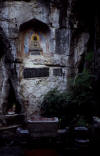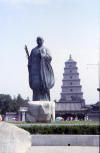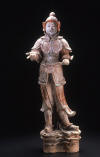|
Sui, Tang and Song Dynasties
"The emperors of the short-lived Sui dynasty (591 -618)
succeeded in reuniting China and prepared the way for the brilliant Tang dynasty
(618 - 906). Under the Tang emperors, China entered a period of unequalled
magnificence. Chinese armies marched across Asia, prompting an influx of
foreign peoples, wealth, and ideas. Arab traders, Nestorian Christians
(members of a sect originating in western Asia), and other travelers journeyed
to the Tang's cosmopolitan capital at Chang'an (modern X'ian), and the Chinese,
in turn, ventured westward. The Tang rulers embellished their empire with
extravagant wooden structures but all have disappeared due to intentional and
unintentional destruction by fire. Judging from records, however, the Tang
buildings were colorfully painted and of colossal size, possessing furnishings
of great luxury and elaborate gold, silver, and bronze ornaments."
- Gardner's
Art Through The Ages,
11th edition, Vol. I, p. 200
"The last century of Tang rule witnessed the
empire's gradual disintegration. When the dynasty finally fell in 906,
China once more experienced the ravages of civil war. Conflicting claims
between rival states went unresolved until the Song dynasty consolidated the
country once again, ruling China from their court at Bianjing (modern Kaifeng in
Henan Province)."
- Gardner's
Art Through The Ages,
11th edition, Vol. I, p. 205
Carved Buddhas, Guilin, China - post-Han period
Brightly painted, beautifully carved Buddhas became a
common artistic expression as Buddhism increased in influence in the 6th and 7th
centuries. The Longmen and Dunhuang cave complexes in northern and western
China, along the Silk Road, each contain hundreds of decorated caves with
thousands of carvings.

Multiple images of the Buddha emerged following the fall of the
Han dynasty with the missionary expansion of Buddhism in China. Among the
most popular was that of Kuan-yin, the feminine goddess of compassion, which
became another incarnation of the Buddha. Androgynous elements
characterize the transitional period of Buddhist imagery of this period.

Big Wild Goose Pagoda, Xian, China
"The pagoda, or tower, the building type most often
associated with Buddhism in China and other parts of eastern Asia, is the most
eye-catching feature of a temple complex. It somewhat resembles the tall
tower form of certain Indian temples and its distant ancestor is the Indian
stupa. Like stupas, many early pagodas housed relics and provided a focus
for devotion to the Buddha as teacher, and to those transmitting the faith.
Later pagodas served other functions, such as housing sacred images."
- Gardner's
Art Through The Ages,
11th edition, Vol. I, pp. 207 - 208

The monk depicted in the statue in the foreground is the
monk Tripitaka, one of the central figures in the 15th century Chinese novel,
Journey to the West.
The Big Wild Goose Pagoda in the background is the repository pagoda for the
Buddhist scriptures which this T'ang Dynasty monk brought back to China from
India. The sculpture is a modern homage to Tripitaka.
Guardian Tomb Figure - Tang Dynasty

Poem Written While on a Boat
"The horizontal scroll, or handscroll, has a long history
as a major format for painting in eastern Asia and was frequently used to
present illustrated religious texts. These scrolls, sometimes exceeding
fifty feet in length, were unrolled to the left and re-rolled from the right,
with only a small section exposed. Priests and other teachers often placed
large-scale instructional scrolls on special stands and presented them to a
small audience. Other scrolls were more intimate in scale and best viewed
by only one or two people at a time. In later periods, the horizontal
scroll also developed as a format for painting continuous landscapes. Art
historians have compared the organization of these paintings to a symphony
because of how motifs reappear and moods vary in different sections. Due
to the unrolling/re-rolling process, appreciation of the landscape scroll
involves memory, as well as vision, and the format encourages leisurely
contemplation."
- Gardner's
Art Through The Ages,
11th edition, Vol. I, p. 198

Summer Mountains - Song Dynasty
"Landscape painting flourished even before the Tang
dynasty. Daoist nature cults and a new appreciation of landscape themes in
poetry provided stimulus for the early development of landscape painting.
Indeed, throughout history, landscape painting played a much more important role
in China than in the West because landscapes had significance far beyond being
sites of human action in great narratives. According to prevailing theory
in China, landscapes should evoke both humanity's ideal harmonious relationship
with the order of the cosmos and nature's potential to transform the human
spirit. The ideal practiced in life meant wandering among streams and
mountains, and a shifting, rather than fixed, perspective in painting suggested
such a viewing process."
- Gardner's
Art Through The Ages,
11th edition, Vol. I, p. 205
"A landscape can take over the composition entirely in
Chinese painting, diminishing or even eliminating figures altogether ...
Artists adopted a more-or-less conventional system for arranging the landscape
elements. A typical Southern Song landscape is basically asymmetrical and
composed on a diagonal. It consists of three parts - the foreground
weighted in one corner, the middle distance, and the far distance. A field
of mist often separates these parts from one another. The painter
generally marked the foreground by a rock, which, by its position, emphasizes
the distance of the other parts. The middle distance may include a flat
cliff or may be given over entirely to mist or water. In the far distance,
mountain peaks, usually tinted in pale blue, suggest the infinity of space.
The whole composition illustrates how the Song artists used great voids to hold
solid masses in equilibrium. The technique is one of China's unique
contributions to the art of painting. ... Such paintings suggest ideals of peace
and unity with nature and the Confucian, Daoist, or Buddhist cosmos."
- Gardner's
Art Through The Ages,
11th edition, Vol. I, p. 209

|